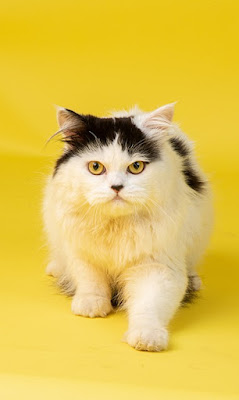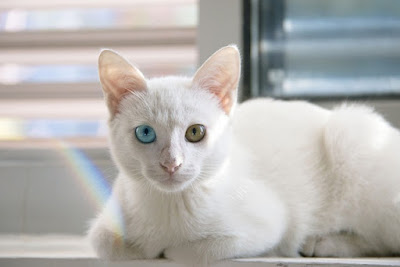When one thinks of the elegance and charm of a pet cat, it is hard not to imagine the beautiful Persian cat. Famous for its attractive appearance, docile temperament and long, flowing hair, the Persian cat has captured the hearts of cat lovers around the world. In this article, we will explore the captivating world of the Persian cat, learning in detail about its history, characteristics, care requirements, and its unique bond with its human companions.
A brief History
The Persian cat originated in the 1600s, making it one of the oldest and most recognized cat breeds. Its journey begins in Persia, modern Iran, where it was initially called "Gorbe-ye Irani" or "Iranian cat". These cats were treasured for their beauty and sweet nature. Eventually, thanks to explorers and traders who recognized their royal allure, they found their way to the courts of Europe.
Features
- Appearance: Persian cats are easily recognizable by their distinctive appearance. They have a round face, a small, upturned nose, expressive eyes and a luxurious, long coat that comes in a variety of colors and patterns. The fluffy tail completes their adorable shape.
- Temperament: Persian cats are famous for their calm and gentle nature. They are generally not known for being high-energy or overly active, which makes them ideal for indoor living. They are affectionate and enjoy quiet, comfortable environments. They form strong bonds with their human companions and thrive on companionship.
- Vocalization: Persians are not particularly vocal cats and communicate through soft, melodious purrs and subtle meows. This calm temperament makes them excellent pets for people who prefer a peaceful home.
- Grooming: Maintaining the Persian cat's long, wavy coat is a labor of love. Regular grooming is essential to prevent matting and maintain their appearance. Daily brushing as well as occasional bathing will keep their fur in pristine condition. They also need to pay attention to the layers of their face to avoid infection.
Care and health
- Nutrition: Providing high-quality cat food is important for the health of a Persian cat. They are prone to dental problems, so regular dental care and feeding dry kibble can help reduce the risk of dental problems.
- Exercise: Although they are not known for their athleticism, it is still important to engage your Persian cat in light play and exercise to prevent obesity. Feather toys and light games are excellent choices to keep them active.
- Grooming: As mentioned earlier, regular grooming is important for the well-being of Persian cats. This breed is prone to hair loss due to its long hair, so grooming also helps reduce this problem.
- Health Concerns: Persian cats are prone to some health issues, including respiratory problems, dental problems, and kidney disease due to their flat faces. It is important to have regular checkups with the veterinarian to monitor their health.
Bond with humans
One of the most endearing qualities of the Persian cat is its deep attachment to its human family. They are known to form deep, emotional bonds with their owners and thrive on affection and attention. These cats often enjoy resting in their human's lap, purring contentedly and looking into their eyes, creating a deep connection that cat lovers cherish.
The Persian cat, with its regal appearance, gentle temperament and strong bond with its human companions, stands out as a remarkable cat breed. Although they may require extra care, grooming and attention, the love and companionship they give in return is truly priceless. For those who appreciate the presence of a calm, elegant and loving cat in their lives, the Persian cat is an ideal choice, symbolizing timeless beauty and companionship.
Here are some interesting Persian cat facts:
- Ancient Origins: Persian cats have a long and storied history, dating back to the 1600s in Persia (modern Iran). She was highly respected for her amazing beauty and humble nature.
- Distinctive Appearance: Persian cats are easily recognizable by their flat, round faces, short nose and expressive, large eyes. Their most iconic feature is their long, luxurious fur, which comes in a variety of colors and patterns.
- Calm and gentle temperament: Persian cats are known for their calm and gentle temperament. They are generally laid-back and enjoy peaceful, relaxing environments. This makes them great companions for people who prefer quiet homes.
- Low Activity Level: Unlike some other cat breeds, Persians are not particularly active or playful. They are more sedentary and are content to lounge around the house.
- Vocality: Persians are generally not very vocal cats. They communicate through soft meows and melodious purrs. Their calm nature makes them ideal for people who appreciate a calm pet.
- Grooming Requirements: Maintaining a Persian cat's long coat can be a significant commitment. They require daily care to keep their hair from getting tangled and matted. Regular bathing and paying attention to their facial layers is also essential.
- Dental Care: Persian cats are prone to dental problems due to their unique facial structure. Regular dental care and feeding dry kibble can help reduce the risk of dental problems.
- Affectionate Companions: Persian cats form strong bonds with their human companions. They thrive on affection and are known to sit in laps, purr, and look into their owners' eyes.
- Health Concerns: This breed is prone to some health issues, including respiratory problems, dental problems, and kidney disease due to their flat face. Regular veterinary checkups are essential to monitor their health.
- Longevity: With proper care and attention to their health, Persian cats can have a relatively long lifespan. On average, they can live for 12 to 16 years or even longer.
- Exquisite Beauty: Persian cats are often considered one of the most beautiful cat breeds in the world. Their luxurious coats, sweet expressions and regal demeanor make them a favorite among cat lovers and photographers.
- Variety of coat colors and patterns: Persian cats come in a wide range of coat colors and patterns, ranging from solid colors like white, black, and cream to various bi-color and tri-color combinations. This diversity increases their attraction.
- Historical Royalty: Throughout history, Persian cats were favored by royalty and the elite. They were prized possessions in the courts of Europe and were featured in royal homes for their exquisite beauty and gentle nature.




Comments
Post a Comment